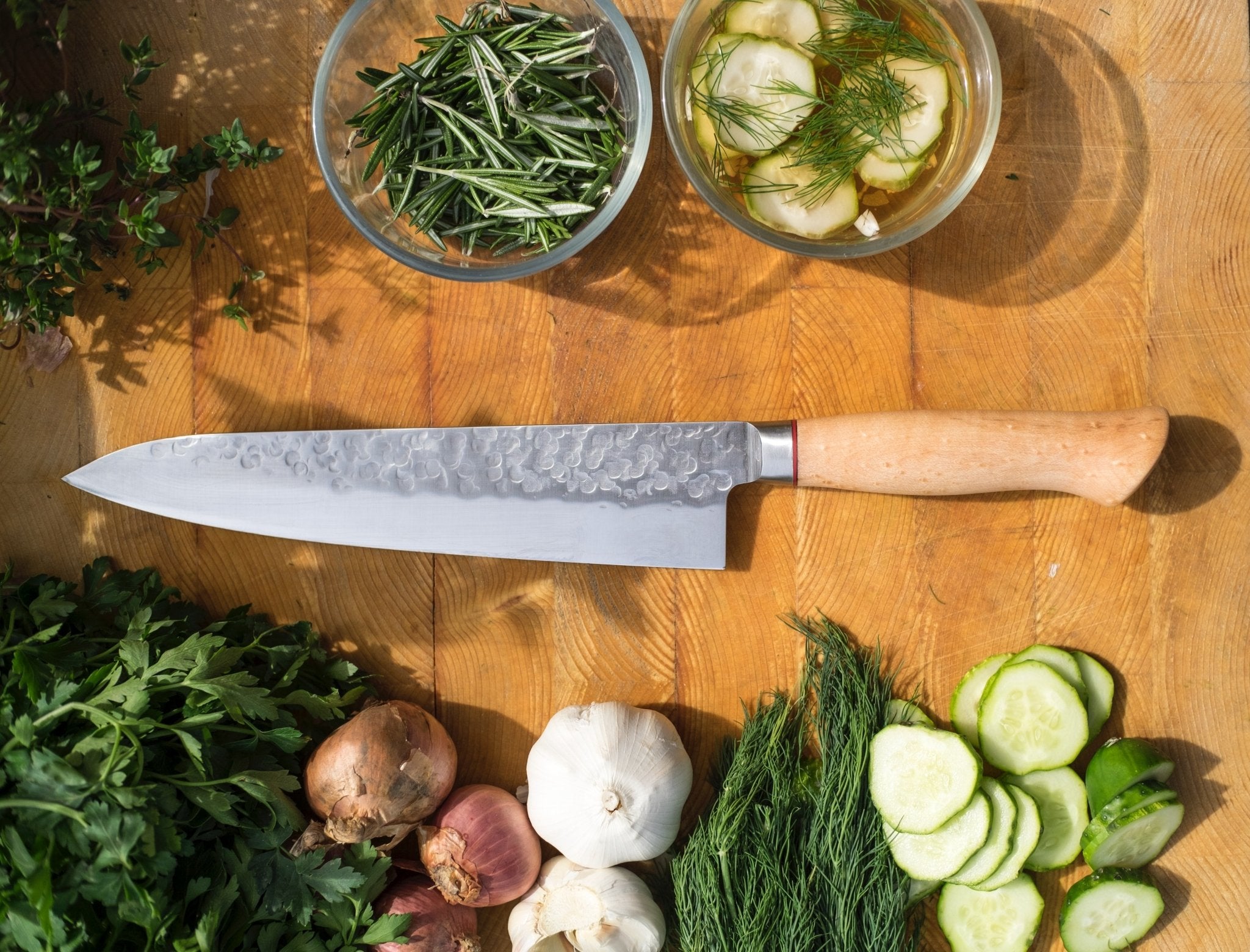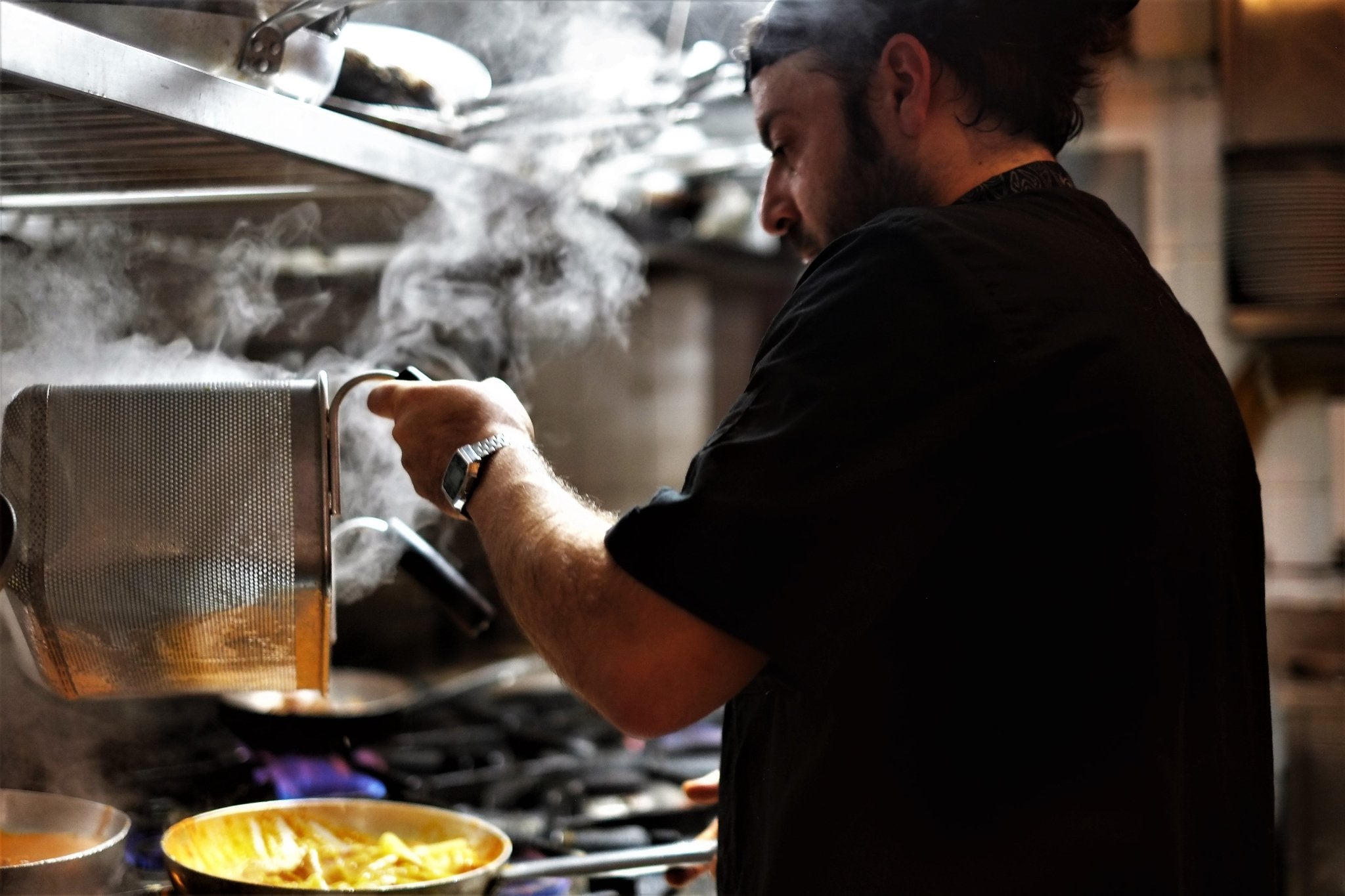What are the Different Types of Knives?

Among all the various kitchen utensils available worldwide, the one kitchen utensil that has evolved through the times is the KITCHEN KNIFE.
A staple product readily found in any kitchen, whether fancy or moderate, a knife is a must-have for everyone who needs to cook.
Some even say it's the one utensil we use in every form of cooking. Think about it with salad, toast, cookies or snacks, we might not even have to cook them, but a knife is needed to cut something.
How are Kitchen Knives Classified?
Knives have various categories. These categories are according to their uses, blade style, the type of steel they are made of, the shape of the blade's edge, and how the steel is made.

Here are some ways in which knives are classified:
The Shape of the Blade:
- French Style Knives, which have a straight blade that curves up at the tip.
- Japanese Style Knives, which have lightweight and very sharp blades.
- German Style Knives, which have blades that curve deeply along the cutting edge of the knife.
Manufacturing Process:
- Forged Knife: This kind of knife is generated from only one metal. It is more expensive and lasts for a long time. Durable, sturdy, simply perfect!
- Stamped Knife: This kind of knife has its blade made from one type of metal, and the handle that is added is made from another steel. The thinner steel of the blade makes this less expensive and much sharper.
Types of Steel:
- Stainless Steel Blade: This material is the most common kind of steel used to make knife blades. This alloy is made using carbon and iron base and then chromium is added to repel stains off the blade and give it a shiny finish that lasts. Hence, the blade is very durable and resistant to corrosion and rust.
- Carbon Steel Blade: Like stainless steel blades, they are made of the same caron and iron base but without chromium. Because of the high carbon count, these steel blades are solid, rigid and have very sharp edges.
- Damascus Steel Blade: The steel of these blades is made of two different alloys hammered together, forging a strong steel with an intricate wavy pattern. It is very durable, strong, and sharp but is often valued for its beauty these days.
There are many other ways of classifying knives, but they are not very common. They are generally thrown under classification under uses like meat knives or vegetable knives.
Here is a list of essential and frequently used kitchen knives by most chefs, home cooks, culinary students - be it professionals or amateurs.
Basic Types of Knives According to their Uses
Chef Knife
Chef Knives are a very much-loved kind of kitchen knife by chefs and non-chefs alike. It is a great all-rounder knife due to its versatility and ability to do almost, if not every, type of cutting in a kitchen. This knife has a long and broad blade that has a straight edge. The blade also has its widest width across the heel, towards the handle of the knife. This widest part of the width then tapers up into a very finely pointed tip. This knife is the most versatile and is perfect for dicing, chopping and mincing vegetables.

Utility Knife
Another knife that many chefs love to use, utility knives are very similar to chef knives. They are smaller than chef knives, and because of this quality, they are great for cutting smaller foods and vegetables.

Although they have almost the same qualities as a chef knife, utility knives are perfect for more precise cutting work with smaller food than chef knives.
Bread Knife
There are breads with different shapes, such as crusty bread, bread rolls, baguettes, bagels, etc. When cutting these kinds of bread, it's often best to use a knife that maintains its shape. This is where the bread knife comes in.

The bread knife is one with a long blade that has a sharp and serrated edge, looking like the edge of a saw. This blade's grooved edge makes it easy to cut through bread without destroying its shape. It can also cut through soft cake.
Cleaver or Butcher Knife
Often in different sizes depending on their use, Butcher knives have a flat and rectangular-shaped blade. This kind of knife is one of the heaviest kinds you can find.

They are used mainly on raw meat and foodstuff that is very hard to cut through, rather than cooked food. The blade's flat surface can also be used to crush tiny food items.
Paring Knife
A paring knife has a slim, short, and evenly sized blade with a pointed tip. A small but mighty knife, it is used for cutting, slicing, and chopping fruits and vegetables. At the same time, it is used for other kitchen tasks like cutting potatoes, peeling, trimming, and removing seeds from fruits and vegetables. The lightweight makes it easy to be handled while doing delicate work.

Filleting Knife
This kind of knife is a fish knife used to remove the bones inside a fish without damaging the flesh of the fish.

This knife is made of a long and slim blade that is very flexible. This blade has a sharp edge and pointed tip, which lets it do its purpose very easily.
Santoku Knife
This knife was initially called Santoku Bocho knife, which means it's a three-use knife. This knife is perfect for three major uses, which is very precise cutting, mincing, and dicing. Originating from Japan, Santoku knives have long, slightly tapered blades and a drop point that allows precise cutting. The blades also have ridges on the edges. These ridges, called kullenschliff or a Granton edge, help prevent food items from sticking to the blade and reduce friction. They are perfect for fish, vegetables, etc.

Carving Knife
A carving knife is very common in kitchens. It has a long and slim blade that tapers to a sharp point. It is used to cut through meat, chicken, pork, lamb, beef, etc. It can also be used to slice large fruits and vegetables.

How Do You Choose the Best Knife?
The choice of which knife is best for you depends on your preferences for some of these Knives' characteristics.

Your choice can depend on the style of the blade, or the kind of steel it is made from, stainless, high carbon, etc.
You can also make your choice considering the handle it has, whether it's ergonomic or not and the material it is made from.
Are you out for durability or sharpness? All of these and more will determine what kind of knife you would like.
Protect Your Knives & Carry Them Safely
Using knives in a kitchen or outside a kitchen daily without proper maintenance can cause the knife to have a shorter usage span. This leads to needing to sharpen or replace it all over again.
Whether it's a butcher knife or a carving knife, a filleting knife or a chef knife, it needs protection to increase its lifespan.
One major way you can protect your knives is by keeping them protected in a sheath and carrying them in a knife roll bag. Lucky for you, Chef Sac offers both!

Our knife bags are a perfect fit for this job. Whether you're a chef, home cook, culinary student or simply a Culinary Maverick, basically, anyone who needs to transport knives from one place to another, these bags are for you.
Made with strong, durable material, the Chef Sac knife rolls have dedicated slots for knives and fastening straps that secure them to avoid any unfortunate accidents.
Spend less on kitchen knives by getting a knife bag today!
- Tags: #Beginner Knife #Chef bags #Chef Essential Tools #Chef's Backpack #Essential Chef Bag Tools #How to Use Knives #Kitchen essential tools #Kitchen Knives #Knife Roll #Knife set #Use Knives #Utensil Roll bag for chefs bags for chefs Chef bag chef sac chef tools Knife bag knife gifts knives
2 comments
-
https://www.morfsteel.com/ on
Great to read, Thanks




Thanks for sharing